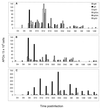Nasal-associated lymphoid tissue is a site of long-term virus-specific antibody production following respiratory virus infection of mice
- PMID: 11333927
- PMCID: PMC114951
- DOI: 10.1128/JVI.75.11.5416-5420.2001
Nasal-associated lymphoid tissue is a site of long-term virus-specific antibody production following respiratory virus infection of mice
Abstract
Nasal immunoglobulin A provides an initial defense against inhaled respiratory pathogens. However, it is not known whether the nasal-associated lymphoid tissues (NALT) are able to mount an effective long-lasting pathogen-specific immune response, nor is it known whether functional differences exist between the organized NALT (O-NALT) and the diffuse NALT lining the nasal passages (D-NALT). Here we show that although both the O-NALT and the D-NALT are capable of producing virus-specific antibody in response to influenza virus infection, the frequency of specific antibody-forming cells in the D-NALT is much greater than the frequency observed in the O-NALT. Furthermore, we show that the D-NALT but not the O-NALT is the site of long-term virus-specific humoral immunity which lasts for the life of the animal. These results indicate that the D-NALT is not only the major effector site of the NALT but also the site of local long-term specific antibody production.
Figures



Similar articles
-
Antibody-forming cells in the nasal-associated lymphoid tissue during primary influenza virus infection.J Gen Virol. 1998 Feb;79 ( Pt 2):291-9. doi: 10.1099/0022-1317-79-2-291. J Gen Virol. 1998. PMID: 9472613
-
Phenotypic and functional differences between lymphocytes from NALT and nasal passages of mice.Scand J Immunol. 2007 Mar;65(3):276-88. doi: 10.1111/j.1365-3083.2006.01898.x. Scand J Immunol. 2007. PMID: 17309783
-
Upper respiratory tract resistance to influenza infection is not prevented by the absence of either nasal-associated lymphoid tissue or cervical lymph nodes.J Immunol. 2005 Sep 1;175(5):3186-96. doi: 10.4049/jimmunol.175.5.3186. J Immunol. 2005. PMID: 16116209
-
[Mucosal immune responses against influenza virus].Nihon Rinsho. 1997 Oct;55(10):2725-31. Nihon Rinsho. 1997. PMID: 9360398 Review. Japanese.
-
Bronchus- and nasal-associated lymphoid tissues.Immunol Rev. 2005 Aug;206:22-31. doi: 10.1111/j.0105-2896.2005.00299.x. Immunol Rev. 2005. PMID: 16048540 Review.
Cited by
-
In Nasal Mucosal Secretions, Distinct IFN and IgA Responses Are Found in Severe and Mild SARS-CoV-2 Infection.Front Immunol. 2021 Feb 25;12:595343. doi: 10.3389/fimmu.2021.595343. eCollection 2021. Front Immunol. 2021. PMID: 33717074 Free PMC article.
-
Design and application of chitosan microspheres as oral and nasal vaccine carriers: an updated review.Int J Nanomedicine. 2012;7:6077-93. doi: 10.2147/IJN.S38330. Epub 2012 Dec 13. Int J Nanomedicine. 2012. PMID: 23271909 Free PMC article. Review.
-
Quantitative analysis of herpes simplex virus type 1-specific memory B cells generated by different routes of infection.Virology. 2007 Mar 30;360(1):136-42. doi: 10.1016/j.virol.2006.10.006. Epub 2006 Nov 17. Virology. 2007. PMID: 17113122 Free PMC article.
-
Biodegradable polymeric microsphere-based vaccines and their applications in infectious diseases.Hum Vaccin Immunother. 2015;11(3):650-6. doi: 10.1080/21645515.2015.1009345. Hum Vaccin Immunother. 2015. PMID: 25839217 Free PMC article. Review.
-
Primary and long-term B-cell responses in the upper airway and lung after influenza A virus infection.Immunol Res. 2014 Aug;59(1-3):73-80. doi: 10.1007/s12026-014-8541-0. Immunol Res. 2014. PMID: 24838149 Review.
References
-
- Asanuma H, Inaba Y, Aizawa C, Kurata T, Tamura S. Characterisation of mouse nasal lymphocytes isolated by enzymatic extraction with collagenase. J Immunol Methods. 1995;187:41–51. - PubMed
-
- Asanuma H, Thompson A, Iwasaki T, Sato Y, Inaba Y, Aizawa C, Kurata T, Tamura S. Isolation and characterisation of mouse nasal-associated lymphoid tissue. J Immunol Methods. 1997;202:123–131. - PubMed
-
- Eichelberger M C, Wang M, Allan W, Webster R G, Doherty P C. Influenza virus RNA in the lung and lymphoid tissue of immunologically intact and CD4-depleted mice. J Gen Virol. 1991;72:1695–1698. - PubMed
Publication types
MeSH terms
Substances
LinkOut - more resources
Full Text Sources
Molecular Biology Databases

